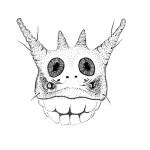We three Dads
The cellar spider has a wonderful gothic, childlike, shivery myth attached to it. Have you heard? Omigod, the daddy long-legs has the most poisonous venom ever discovered! but, like, its little fangs can’t penetrate human skin so nobody even knows, so you could be totally killed by it, but nobody ever is.
This wacky idea actually seems to be dying out, even among the swaggering schoolchildren who answer most Internet queries. “Mythbusters” got around to addressing it a while back (yes, Adam got bit. No, he didn’t die. Maybe he exaggerated a bit about the bite, which he didn’t even show, but how long can a camera show nothing happening?). It probably takes a hit Discovery program to begin to turn the tide of Internet nonsense, especially when it comes to such a durable and colorful tale.
The cellar spider, one of several dudes dubbed “daddy,” looks like something made out of mini-marshmallows and pipe cleaners. A spindly, fragile thing that offers the most florid display of timidity in nature: if you touch its web, it trembles. Think of that, you “Lord of the Flies” schoolkids with your misspelled boasts about pulling off its legs, one at a time. It just shivers and waits for you to go away.
Who’s your daddy, long-legs? Now about that name. You have to brush past the stiff angry online Commenters who shout that the daddy long-legs is NOT a spider or else the daddy long-legs is TOO a poizinus spider and one bit my cusin and her elbo fell off and get to the place where it’s clear that “daddy long-legs” means three different animals:
1. A spider. Two common species (very common, actually) of the family Pholcidae that live in my area are Pholcus phalangioides and Holocnemus pluchei, the latter known as the marbled cellar spider. Neither belongs here; they’re among those pushy Eurotrash species that arrived at some unknown time, eclipsing the native spiders. And they really like it here.
2. An arachnid called a harvestman. Strange little striding bug, it looks like the invader vehicles you imagined the first time you read “War of the Worlds,” with a tiny gondola suspended at the vertex of eight immensely long, thin legs. Not a spider, not venomous. It eats everything in the garden but can’t bite you. Defends itself by making a funny smell.
3. A crane fly. California has more than 400 species of this bug, which turns from a grub in the ground to a flying insect. Harmless, though it resembles a giant mosquito. Scientists identify a larva by looking at its rear end, through which it breathes, and which is decorated with eye-popping, grotesque patterns that look like Mardi Gras masks (below). In my family we called crane flies gallinippers, a name I thought my own daddy made up because he has a knack for wordplay (big mosquito = gallon nipper), but I learned that not only is this a folk name, but “gallinipper” is also used for an actual huge bloodsucking mosquito and not just the innocent crane fly.

This is one crane fly’s southern exposure! Aw, I’m gonna have nightmares now. (Nephrotoma virescens illustration © Chen Young)
Also it’s a bluegrass band, one that proudly proclaims “The Gallinippers is on Facebook!” And so they is.
Also, there’s a silly poem:
. . . Then Mr. Daddy Long-legs
And Mr. Floppy Fly
Rushed downward to the foamy sea
With one sponge-taneous cry;
And there they found a little boat,
Whose sails were pink and gray;
And off they sailed among the waves,
Far, and far away.
(Edward Lear, “The Daddy Long-Legs and the Fly”)
The cellar spider is the dad I know well. It lives in a world of dim sunlight, sawdust, splinters, old storage smells. Your basement, attic, or garage. Or, if you’re casual about housecleaning, the no-dad’s-land behind a desk or sideboard or bookcase. The spider makes a messy web that it’s agreeable to sharing with fellow spiders, where they all hang upside-down, snagging flying bugs, vibrating like little cell phones when disturbed.
Even the pest-control folks, always eager to suggest ways of annihilating local fauna, have nothing bad to say about the cellar spider except that the webs are “unsightly.” It was still worth several people’s time to write about the best ways to keep those dirty dads under control, though (hint: vacuuming and judicious use of pesticide).
The only thing I dislike about Daddy is that he poops in corners. Any nook occupied by a cellar spider is going to have dark-and-light spatters on the floor or shelf below. It’s not the easiest of spooges to clean up, either, and it makes the surroundings look drear and grimy. The cellar spider, not the tarantula or widow, is the spider that should have the role of Halloween gloom-meister, since its presence indicates a place disused or abandoned or otherwise atmospheric. Otherwise it’s about as spooky as a kitten.
It’s not scary and (unlike a jumping spider) it can’t dance—in sharp contrast to Fred Astaire, title character of the silky 1955 musical “Daddy Long Legs.” Watch as the grand old hoofer ensnares young Leslie Caron in a web of dance, for which she is grateful and adorable and extremely French. Sweet story. It surprised me to learn how many versions of that film were made in the last century, with different actors as the daddy. Sometimes the leggy leading man—harmless, never venomous—snares Mary Pickford, sometimes Janet Gaynor, once an anime orphan, once even (gasp) Shirley Temple, though in that version (“Curly Top,” 1935) Daddy does the nuptial dance with the moppet’s grown-up sister, not Shirley (*whew*).
What do those old movies have to do with cellar spiders? Nothing, though for once it’s nice to associate a spider with a silly fable not having to do with gangrene. And by the way, I’d take Leslie Caron (“Daddy Long Legs”) over Theresa Russell (“The Black Widow”) any day.


